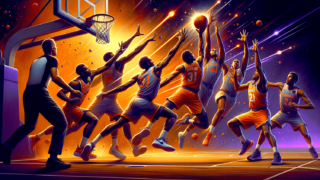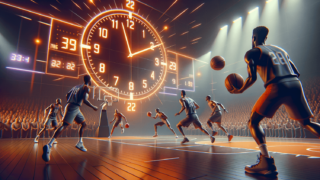
Basketball Held Ball Rule: How It Affects Game Flow
Written by: Basketball Universe
Last updated:

Welcome to our deep dive into the exciting world of basketball rules! In this blog post, we will be dissecting the ins and outs of the often misunderstood “held ball” rule and exploring its impact on the game’s overall flow. As you lace up your sneakers and prepare for an illuminating journey down the court, we invite you to join us in unlocking the true essence of this fascinating aspect of basketball. By the end, you’ll have an expert-level understanding of the held ball rule and how it weaves into the dynamic tapestry of the game we all know and love. Ready to slam dunk into the knowledge hoop? Let’s go!
Basketball Held Ball Rule: How It Affects Game Flow
The basketball held ball rule occurs when two opposing players simultaneously gain possession of the ball or when a player is unable to move due to a defender’s pressure. This results in a jump-ball situation, with possession awarded to the team based on the possession arrow. The held ball rule impacts the game flow by creating crucial dead-ball scenarios, allowing both teams potential momentum shifts and strategic plays.
Understanding the Held Ball Rule in Basketball
Before diving into the intricacies of the held ball rule and its impact on game flow, it’s essential to understand what constitutes a held ball situation. As per the official basketball rules, a held ball occurs when two opposing players simultaneously gain possession of the ball, or when a player in possession finds themselves unable to move due to the pressure exerted by a defender. This leads to a dead-ball situation, with the possession arrow determining which team gains control of the ball.
Jump-ball Situations and the Possession Arrow
To further comprehend the held ball rule’s influence on game flow, we must first consider the concepts of jump-ball situations and the possession arrow. At the start of the game, a jump ball is held, and the team that wins the tip-off secures the first possession. Following the initial jump ball, possession alternates between teams according to the possession arrow as held ball situations arise.
Jump-ball Situations: A Closer Look
Jump-ball situations typically emerge in one of three scenarios. Firstly, held ball situations trigger jump balls. Secondly, when the ball goes out of bounds and the officials cannot determine which team touched it last, a jump-ball situation ensues. Lastly, if a double personal foul occurs and neither team already has possession of the ball, this results in a jump-ball situation. While the first and third scenarios are explicitly related to held balls, understanding all jump-ball situations is critical for appreciating the held ball rule’s power in shaping game flow.
The Importance of the Possession Arrow
The possession arrow is an invaluable tool that minimizes confusion and maintains order on the basketball court. Situated at the scorer’s table, the arrow indicates which team will gain possession in the event of a held ball scenario or certain jump-ball situations. The arrow points towards the team’s basket that is eligible for possession, and once the possession is granted, the arrow is flipped, indicating the other team will gain control in the event of the next held ball situation.
How the Held Ball Rule Affects Game Flow
At first glance, the held ball rule may seem insignificant or simple; however, its impact on game flow becomes apparent through a closer examination of various basketball scenarios. A held ball situation can break down offensive plays, create momentum shifts, and provide opportunities for strategic adjustments. Understanding the subsequent ripple effects is crucial to unlocking the deeper nuances of the held ball rule and its role within the context of basketball.
Interrupting Offensive Plays and Defensive Strategies
When a player driving to the basket becomes entangled with a defender and a held ball occurs, the offensive play comes to an abrupt halt. Even though the held ball rule interrupts the play, this occurrence showcases the defenders’ tenacity and commitment to disrupting their opponents’ game plan. As the game progresses, the held ball rule can cause the offense to tread carefully and make adjustments to avoid the defender snatching away another possession.
Creating Momentum Shifts in the Game
Often, basketball games are decided by momentum swings that can shift the tide in either team’s favor. Held ball situations can spark these momentum shifts. For instance, a team on a scoring drought may be invigorated by forcing a held ball and securing possession, potentially turning the tide of the game. Conversely, a team dominating the game could solidify its position by hustling for a loose ball and engaging in a held ball situation, denying the opposition a crucial possession.
A Unique Tool for Strategic Adjustments
The held ball rule not only provides an opportunity for players on the court to showcase their grit and determination but also creates strategic considerations for coaches. With deliberate coaching, players can work on developing techniques to force held ball situations and the subsequent possession arrow changes. Conversely, offensive players can be coached to avoid getting trapped in held ball situations, maintaining control of the ball and keeping the game flow intact.
The Held Ball Rule: A Key Element in Basketball Rules
While the held ball rule might initially appear as an isolated event within the broader tapestry of basketball rules, it is a powerful tool that impacts game flow in surprising ways. By understanding the principles of the possession arrow and how held ball situations may emerge, we begin to appreciate its significance and interplay with other aspects of the game.
Held Ball Rule and Sportsmanship
The held ball rule encourages players to display sportsmanship on the court. It fosters a competitive environment in which players from opposing teams can engage in a fair contest for the ball. Furthermore, the rule minimizes the possibility of disagreements escalating into physical altercations, ensuring that the game remains focused on skill, technique, and teamwork.
Influence on Transition Basketball
The fast-paced nature of transition basketball is occasionally disrupted by held ball situations. These dead-ball scenarios compel teams to reset their defenses and employ their half-court offensive sets. Additionally, held balls provide an opportunity for coaches to impart last-minute instructions or adjustments to their players, enabling a more strategic approach to unfolding game situations.
Implications for Youth and Amateur Basketball
Youth and amateur basketball players can benefit immensely from understanding the held ball rule, as it allows them to focus on essential skills such as awareness, positioning, and anticipation. By mastering these skills, young players can better prepare for more advanced levels of play where the held ball rule’s strategic nuances are further elaborated.
In conclusion, the held ball rule constitutes a vital component of the beautiful game of basketball. By comprehending the rule’s mechanics and its influence on game flow, players, coaches, and fans alike can gain a more profound appreciation of the sport and the complex strategies that emerge in the heat of competition. Whether you’re an aspiring basketball star or a seasoned coach, a firm grasp of the held ball rule equips you with the knowledge to maximize the opportunities it presents and to elevate your understanding of the game to a whole new level.
Defensive Techniques to Force Held Ball Situations
While the held ball rule can impact the flow of a basketball game in various ways, it’s essential to recognize the defensive techniques and strategies players can use to force these situations. Players who can effectively trigger held ball scenarios can disrupt their opponents’ offensive setups, seize possession, and create momentum for their team. Here are some defensive techniques to keep in mind:
Active and Positional Hands
Defensive players should use active hands to maximize the chances of creating held ball situations. This involves swiping at the ball, maintaining proper hand positioning, and anticipating passes or dribbling moves by the offense. By using their hands effectively, defenders can disrupt their opponents’ rhythm, catch them off guard, and force more held balls.
Closing Out on Shooters
Closing out on shooters is another effective way to create held ball situations. As the offensive player attempts a shot, the defender should close the gap as quickly as possible and place a hand in the shooter’s line of sight. The increased pressure may cause the shooter to hesitate, potentially giving the defender an opportunity to grab the ball and provoke a held ball situation.
Aggressive Trapping
When executed correctly, aggressive trapping can be a valuable tool for forcing held balls. Defenders can initiate traps by cutting off passing lanes or doubling up on an opponent to pressure them into making a mistake. The increased pressure often leads to tangled limbs and held ball situations, which can result in a changed possession arrow in the trapping team’s favor.
Offensive Techniques to Prevent Held Ball Situations
On the flip side, offensive players need to develop techniques to prevent held ball situations and protect their team’s chances for maintaining possession. Keeping the ball secure and avoiding traps are critical in minimizing the defense’s ability to create these game-altering scenarios. Here are some offensive techniques to prevent held ball situations:
Ball Security
One of the most basic ways to prevent held ball situations is to prioritize ball security. Offensive players should focus on keeping the ball close to their bodies and using their bodies to shield it from defenders. They should also avoid over-dribbling and maintain a low stance to prevent defenders from swiping the ball or tying it up.
Avoiding Predictable Offense
To protect against held ball situations, offensive players should avoid being predictable. Frequently changing direction, using pump fakes, and employing a variety of offensive moves can disrupt defenders’ attempts to force held balls. By staying unpredictable, offensive players also maintain offensive flow and decrease the chances of a defensive stop.
Battling Through Defensive Pressure
Fighting through defensive pressure is key in minimizing held ball situations. Offensive players should work on staying composed, even when faced with intense defense, and maintain a strong base when attempting a shot or protecting the ball. By remaining calm and employing proper techniques, players can navigate through tight defensive coverage without succumbing to held ball scenarios.
Overall, understanding and mastering the various offensive and defensive strategies related to the held ball rule can significantly impact the dynamics on the court. By continuously refining these techniques and tactics, players can optimize their skill sets and better contribute to the overall flow and strategy of the game.
Frequently Asked Questions
We understand that readers may have some burning questions about the held ball rule in basketball and how it affects game flow. To address some of these concerns, we have compiled a list of ten common questions and provided concise answers for each. This FAQ section addresses any lingering doubts and sheds more light on the intricacies of the held ball rule.
1. When does a held ball situation occur?
A held ball situation occurs when two opposing players simultaneously gain possession of the ball or when a player in possession finds themselves unable to move due to the pressure exerted by a defender.
2. How is possession awarded after a held ball situation?
Following a held ball situation, possession is awarded to the team indicated by the possession arrow. After each held ball situation, the arrow is flipped to alternate possession between the teams.
3. What is the purpose of the possession arrow?
The possession arrow minimizes confusion and maintains order during a basketball game. It indicates which team will gain possession next in the event of a held ball or certain jump-ball situations.
4. Can a held ball situation change the momentum of a game?
Yes, held ball situations can create momentum shifts in a game. They can invigorate a team struggling to score or solidify the position of a dominating team by denying the opposition a crucial possession.
5. How does the held ball rule impact offensive plays and defensive strategies?
The held ball rule can interrupt offensive plays by abruptly stopping them, compelling the offense to make adjustments to avoid held ball situations. Defensively, it allows players to showcase their tenacity by disrupting their opponents’ game plan and potentially gaining possession.
6. What are some defensive techniques to force held balls?
Defensive players can use active and positional hands, close out on shooters, and employ aggressive trapping to force held ball situations and increase the chances of gaining possession for their team.
7. What can offensive players do to prevent held ball situations?
To prevent held ball situations, offensive players should ensure proper ball security, avoid predictable offense, and battle through defensive pressure. This helps them maintain possession, while minimizing the chances of a defensive stop.
8. Why is it important for youth and amateur basketball players to understand the held ball rule?
Understanding the held ball rule helps youth and amateur basketball players develop essential awareness, positioning, and anticipation skills. By mastering these, they are better prepared for more advanced levels where the strategic nuances of the held ball rule come into play.
9. How does the held ball rule promote sportsmanship?
The held ball rule encourages fair competition by ensuring that players from opposing teams engage in a contest for the ball. It also reduces the likelihood of disagreements escalating into physical altercations, maintaining the game’s focus on skill, technique, and teamwork.
10. How does the held ball rule affect transition basketball?
Held ball situations may disrupt the fast-paced nature of transition basketball by forcing teams to reset their defenses and utilize half-court offensive sets. These dead-ball scenarios also give coaches the opportunity to convey last-minute instructions or adjustments to their players, enabling a more tactical approach to game situations.
Featured Posts
- No pillar pages found.





